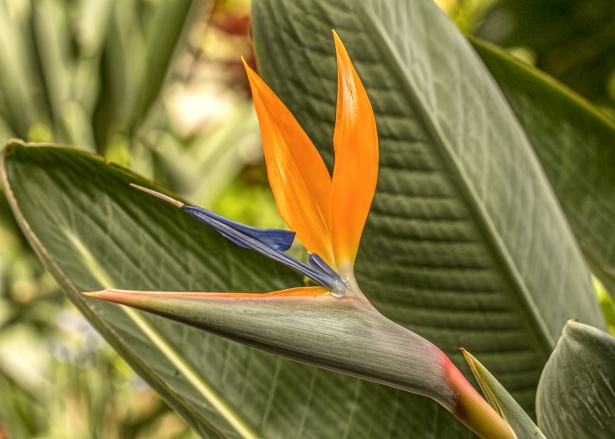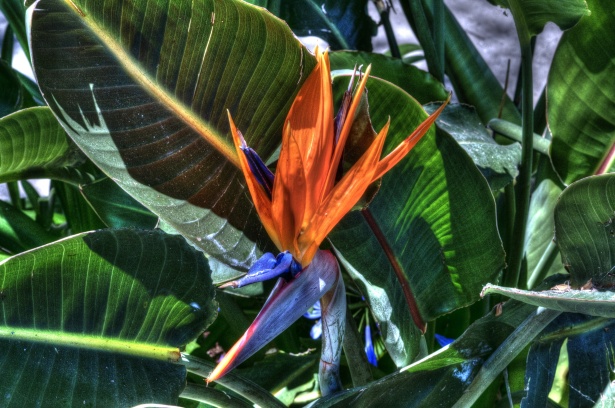How to Care for the Bird of Paradise

The bird of paradise can brighten up any garden area. This exotic plant that is a native of South Africa produces beautiful colorful flowers which can give that WOW. I have worked with this flowering plant many times on garden projects and to be honest with you I have always been blown away at their amazing colors.
The leaves of the bird of paradise also resemble a banana tree but don’t be fool by this because this tropical beauty makes a good centerpiece or specimen plant that brings that tropical feeling. The five-star resort which I was employed many years ago installed these babies throughout the property which brought that much-needed flavor giving that color POP.
Bird of paradise for the interior
Apart from being a groundsman, my other duties involved working with the interior plantscape crew where we brought nature indoors by creating many beautiful garden designs and you guess it the bird of paradise was called upon yet again to work its wonders as we dazzled visitors from around the world bringing that spice and adding that touch of class to the indoors.
But how do we grow and care for these plants that are a favorite of the tropics? Stick around and find out so you can include these tropical beauties in your garden which will not only give that bright color but will also enhance your garden’s overall design.
How to grow a bird of paradise plant?
In order to be successful at growing and caring for a bird of paradise, these are the things that must be considered.
- Location
- Soil Type
- Watering Needs
- Fertilizer
- Temperatures
- Disease
- Garden insect pests
Location
The choice of location should be an area that gets lots of sunlight but a bird of paradise can do well in partial shade also.
Soil Type
The bird of paradise prefers a soil that is not only loamy and rich but a soil that also has good drainage. This type of garden soil will not only retain moisture and fertilizer but will have good air circulation which is great for soil microbes as they are hard at work ensuring that your plant is growing healthy.
How to water your bird of paradise?
Although the soil of the bird of paradise should be kept moist be very careful when watering because you don’t want to overwater which will contribute to root rot. A sign of your bird of paradise getting too much water shows up in the leaves turning yellow. During the hotter months which include spring and summer, it is good to keep the soil moist but in the fall and winter seasons, it is best to allow the soil to dry out somewhat before watering.
How to fertilize your bird of paradise?
Fertilizers are plant nutrients that are so beneficial to garden plants but applying fertilizers incorrectly can damage your bird of paradise. Using a slow or quick-release fertilizer will work wonders. Before fertilizing follow the manufactures label because the label is the law.
Temperatures
Because the bird of paradise favors tropical conditions temperatures that don’t meet its requirements will have an adverse effect, therefore, it’s important that your plant is exposed to temperatures from 60-7o degrees F during the day hours and a little lower during nighttimes. A good idea to ensure that your bird of paradise is always exposed to the right temperatures is by planting in containers that way you can move your plant to a more secure and warm area away from the nighttime chill.
Garden insect pests of the bird of paradise
The bird of paradise has its share of insect pests and if left unchecked will cause damage. These are the insect’s pests to keep a close watch for.

- Scale
- Aphids
- Mealybugs
- spider mites
- snails
- Caterpillars
Scales, aphids, mealybugs, and spider mites can be controlled with a mixture of soap and water or cleaning plants with rubbing alcohol. Another solution is to apply insecticidal soap. When it comes to treating snails and caterpillars handpicking and throwing them in a bucket of soapy water will eliminate them.
Diseases of the bird of paradise
The listed disease of the bird of paradise is as followed.
- Root Rot
- Leaf Blight
- Bacterial Wilt
Root rot occurs because of poor drainage, to avoid this disease ensure that the soil your bird of paradise is installed in has good drainage and do not overwater your bird of paradise but water according to the plant’s requirements.
Leaf blight symptoms show up as white spots on the leaves and green rings around the spots. To treat this disease the use of applying fungicides to the soil will offer some help.
Bacterial wilt causes the leaf to be discolored or turn light green if this disease is not treated immediately the leaves will wilt before death sets in. If this system describes your bird of paradise ensure that the soil dries out along with applying a fungicide.
Container grown bird of paradise
If you are growing your bird of paradise in a container to be placed on the inside ensure that the area where you are installing your plant gets lots of bright sunlight, don’t allow your plant to be exposed to direct sunlight because this exposure will cause the leaves to burn. The soil as we discussed earlier when installing your bird of paradise in your garden should be the same. That is a soil that has good drainage.
The container must have drain holes to allow excess water to drain through if possible providing a saucer to catch the water that drains offers much help. The saucer should be emptied so it won’t be a breeding ground for mosquitoes. During the growing season which is spring and summer the soil should be kept moist but in the colder months allow the soil to dry out somewhat between watering.
If you can it is better to use rain or distilled water because the salt content in tap water may be high which can burn plant leaves. Insects pest that attacks birds of paradise which is grown indoors is spider mites scales and mealybugs. To control these pests apply warm soapy water to a cloth and gently wipe the leaves. Fertilize your bird of paradise with a water-soluble fertilizer, during the winter months fertilizing your plant can be discontinued until the following spring when the growing season starts again.
The final word
Installing a bird of paradise in your garden or interior makes a great addition that will give that much-needed flavor as it brightens your world. The time invested is worth the effort as you introduced that tropical look into your garden and landscapes so go ahead you will be glad that you did as these flowers enhance your surroundings bringing that touch of class. Now that’s an investment that will pay off in big ways.
About the author
Norman loves being in the garden, both at home and for his job....
he is 'Natures Little helper' being outdoors, growing his vegetables and flowers from an early age.
Now having spent over 22 years in the profession he want to give some of his knowledge to others...
his vast array of hints and tips you will find scattered over this site will help you no end growing plants in your garden.
